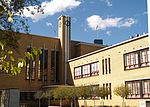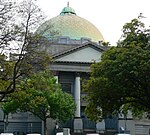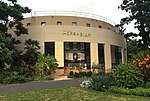MacRobertson Girls' High School buildings

The MacRobertson Girls’ High School buildings are a series of heritage-listed buildings constructed on the site of the Mac.Robertson Girls' High School, located on the Kings Way, in Albert Park, South Melbourne, Victoria, Australia. The girls' school and the campus is named in honour of Sir Michael Macpherson Robertson after MacRobertson donated £100,000 to the State of Victoria, £40,000 of which was spent to construct the school. Norman Seabrook of Seabrook and Fildes architecture practice, designed the building after winning the state-wide design competition with his functional and modern design entry in the Inter-war Functionalist & Moderne style.: 35 Constructed in 1934 during centenary celebrations of Victoria, MacRobertson was vital to the progress of modernist architecture in Australia and essential in the strong re-emergence of the state after the economic downturn of the depression.: 34 The building was listed on the Victorian Heritage Register on 23 May 1998 due to the buildings' architectural, historic and social significance to the State of Victoria.
Excerpt from the Wikipedia article MacRobertson Girls' High School buildings (License: CC BY-SA 3.0, Authors, Images).MacRobertson Girls' High School buildings
Albert Road, Melbourne Melbourne
Geographical coordinates (GPS) Address Nearby Places Show on map
Geographical coordinates (GPS)
| Latitude | Longitude |
|---|---|
| N -37.836 ° | E 144.9722 ° |
Address
MacRobertson Girls' High School
Albert Road
3004 Melbourne, Melbourne
Victoria, Australia
Open on Google Maps











